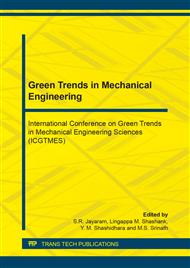[1]
J. Sun, W. Wang, Q. Yue, C. Ma, J. Zhang, X. Zhao, Z Song, Review on microwave–metal discharges and their applications in energy and industrial processes, Applied Energy. 175 (2016) 141-157.
DOI: 10.1016/j.apenergy.2016.04.091
Google Scholar
[2]
J. Sun, W. Wang, Q. Yue, Review on microwave-matter interaction fundamentals and efficient microwave-associated heating strategies, Materials. 9(4) (2016) 231.
DOI: 10.3390/ma9040231
Google Scholar
[3]
W. Wang, L. Fu, J. Sun, S. Grimes, Y. Mao, X. Zhao, Z. Song, Experimental study of microwave-induced discharge and mechanism analysis based on spectrum acquisition, IEEE Transactions on Plasma Science. 45(8) (2017) 2235-2242.
DOI: 10.1109/tps.2017.2715800
Google Scholar
[4]
W. Wang, Z. Liu, J. Sun, Q. Ma, C. Ma, Y. Zhang, Experimental study on the heating effects of microwave discharge caused by metals, AIChE Journal. 58(12) (2012) 3852-3857.
DOI: 10.1002/aic.13766
Google Scholar
[5]
W. Chen, B. Gutmann, C. O. Kappe, Characterization of Microwave‐Induced Electric Discharge Phenomena in Metal–Solvent Mixtures, ChemistryOpen. 1(1) (2012) 39-48.
DOI: 10.1002/open.201100013
Google Scholar
[6]
A. G. Whittaker, D. M. P. Mingos, Arcing and other microwave characteristics of metal powders in liquid systems, Journal of the Chemical Society. (9) (2000) 1521-1526.
DOI: 10.1039/b000462f
Google Scholar
[7]
A. G. Whittaker, D. M. P. Mingos, Synthetic reactions using metal powders under microwave irradiation, Journal of the Chemical Society. (21) (2002) 3967-3970.
DOI: 10.1039/b206557f
Google Scholar
[8]
J. Sun, W. L. Wang, C. Y. Ma, Q. Y. Yue, Study on the promotion effect of microwave-metal discharge on the microwave pyrolysis of electronic waste, In Advanced Materials Research. 1088 (2015) 843-847.
DOI: 10.4028/www.scientific.net/amr.1088.843
Google Scholar
[9]
J. Sun, W. Wang, Z. Liu, Q. Ma, C. Zhao, C. Ma, Kinetic study of the pyrolysis of waste printed circuit boards subject to conventional and microwave heating, Energies. 5(9) (2012) 3295-3306.
DOI: 10.3390/en5093295
Google Scholar
[10]
H. B. Al-Wakeel, Z. A. Karim, H. H. Al-Kayiem, Optimizing electro-thermo Helds for soot oxidation using microwave heating and metal, In IOP Conference Series: Materials Science and Engineering. 78 (1) (2015) 012018.
DOI: 10.1088/1757-899x/78/1/012018
Google Scholar
[11]
J. G. Titto, A. K. Sharma, P. Kumar, A feasibility study on drilling of metals through microwave heating, i-Manager's Journal on Mechanical Engineering. 2(2) (2012) 1.
Google Scholar
[12]
T. J. George, A. K. Sharma, P. Kumar, R. Kumar, S. Das, Microwave Drilling: Future Possibilities and Challenges Based on Experimental Studies, In International Conference on Emerging Trends in Manufacturing Technology, Toc H Institute of Science & Technology. Kerela (2012).
Google Scholar
[13]
N. K. Lautre, A. K. Sharma, P. Kumar, Distortions in hole and tool during microwave drilling of perspex in a customized applicator, In Microwave Symposium (IMS). (2014)1-3.
DOI: 10.1109/mwsym.2014.6848410
Google Scholar
[14]
N. K. Lautre, A. K. Sharma, P. Kumar, S. Das, Performance of different drill bits in microwave assisted drilling, International Journal of Mechanical Engineering and Robotics Research. 1(1) (2014) 22-29.
Google Scholar
[15]
N. K. Lautre, A. K. Sharma, P. Kumar, S. Das, Microwave drilling with Litz wire using a domestic applicator, Bonfring International Journal of Industrial Engineering and Management Science. 4(3) (2014) 125.
DOI: 10.9756/bijiems.6053
Google Scholar
[16]
N. K. Lautre, A. K. Sharma, P. Kumar, S. Das, A photoelasticity approach for characterization of defects in microwave drilling of soda lime glass, Journal of Materials Processing Technology. 225 (2015) 151-161.
DOI: 10.1016/j.jmatprotec.2015.05.026
Google Scholar
[17]
N. K. Lautre, A. K. Sharma, P. Kumar, S. Das, A simulation approach to material removal in microwave drilling of soda lime glass at 2.45 GHz, Applied Physics A. 120(4) (2015) 1261-1274.
DOI: 10.1007/s00339-015-9370-2
Google Scholar
[18]
N. K. Lautre, A. K. Sharma, P. Kumar, S. Das, On Crack Control Strategy in Near-Field Microwave Drilling of Soda Lime Glass Using Precursors, Journal of Thermal Science and Engineering Applications. 7(4) (2015) 041001.
DOI: 10.1115/1.4030478
Google Scholar
[19]
G. Kumar, A. K. Sharma, Role of dielectric fluid and concentrator material in microwave drilling of borosilicate glass, Journal of Manufacturing Processes. 33 (2018)184-193.
DOI: 10.1016/j.jmapro.2018.05.010
Google Scholar


